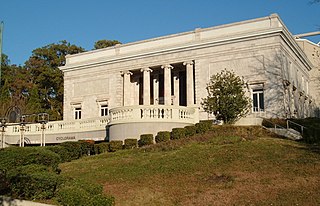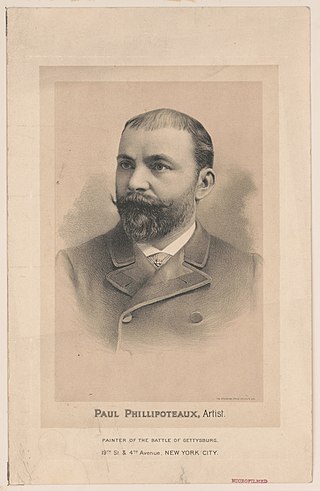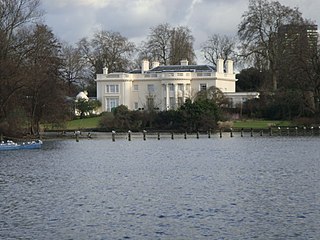
Panoramic paintings are massive artworks that reveal a wide, all-encompassing view of a particular subject, often a landscape, military battle, or historical event. They became especially popular in the 19th century in Europe and the United States, inciting opposition from some writers of Romantic poetry. A few have survived into the 21st century and are on public display. Typically shown in rotundas for viewing, panoramas were meant to be so lifelike they confused the spectator between what was real and what was image.

A panorama is any wide-angle view or representation of a physical space, whether in painting, drawing, photography, film, seismic images, or 3D modeling. The word was coined in the 18th century by the English painter Robert Barker to describe his panoramic paintings of Edinburgh and London. The motion-picture term panning is derived from panorama.
A cyclorama is a panoramic image on the inside of a cylindrical platform, designed to give viewers standing in the middle of the cylinder a 360° view, and also a building designed to show a panoramic image. The intended effect is to make viewers, surrounded by the panoramic image, feel as if they were standing in the midst of the place depicted in the image.

The Atlanta Cyclorama and Civil War Museum was a Civil War museum located in Atlanta, Georgia. Its most noted attraction was the Atlanta Cyclorama, a cylindrical panoramic painting of the Battle of Atlanta. As of December 2021, the Cyclorama is located at the Atlanta History Center, while the building is now Zoo Atlanta's Savanna Hall.

A cosmorama is an exhibition of perspective pictures of different places in the world, usually world landmarks. Careful use of illumination and lenses gives the images greater realism.

Panorama Mesdag is a panorama by Hendrik Willem Mesdag. Housed in a purpose-built museum in The Hague, the panorama is a cylindrical painting more than 14 metres high and about 40 metres in diameter. From an observation gallery in the centre of the room the cylindrical perspective creates the illusion that the viewer is on a high sand dune overlooking the sea, beaches and village of Scheveningen in the late 19th century. A foreground of fake terrain around the viewing gallery hides the base of the painting and makes the illusion more convincing.
The Battle of Gettysburg, also known as the Gettysburg Cyclorama, is a cyclorama painting by the French artist Paul Philippoteaux depicting Pickett's Charge, the climactic Confederate attack on the Union forces during the Battle of Gettysburg on July 3, 1863.

Paul Dominique Philippoteaux was a French artist. He is best known for a cyclorama illustrating the Battle of Gettysburg.

Robert Barker was a famous painter from Kells, Co. Meath, Ireland.

The Cyclorama Building is an 1884 building in the South End of Boston, Massachusetts that is operated by the Boston Center for the Arts.

Henri Félix Emmanuel Philippoteaux was a French artist and illustrator, known primarily as a battle painter.
Thomas Hornor (1785–1844) was an English land surveyor, artist, and inventor.
The Arrival of the Hungarians is a large cyclorama – a circular panoramic painting – by Hungarian painter Árpád Feszty and his assistants, depicting the beginning of the Hungarian conquest of the Carpathian Basin in 895.

The Ópusztaszer National Heritage Park is an open-air museum of Hungarian history in Ópusztaszer, Hungary. It was established in 1982 and is most famous for being the location of the Feszty Panorama, a cyclorama by Árpád Feszty and his assistants, depicting the beginning of the Hungarian conquest of the Carpathian Basin in 895. The painting was completed in 1894 for the 1000th anniversary of the event. The park is also home to various indoor and outdoor exhibits, focusing on the archaeological and ethnographic history of ancient and early-modern Hungary in an immersive and engaging manner.

Edmund Thomas Parris was an English history, portrait, subject, and panorama painter, book illustrator, designer and art restorer. He was appointed history painter to Queen Adelaide, Queen Consort of William IV, and painted Queen Victoria's coronation in 1838 and the Duke of Wellington's funeral in 1852. He supervised the painting of the huge panorama in the London Colosseum in Regent's Park, London, and was the inventor of "Parris's medium".

The Dresden Panometer is an attraction in Dresden, Germany. It is a venue displaying one of two panoramic paintings of Austrian-born artist Yadegar Asisi inside a former gasometer, accompanied by an exhibition. One of the two panoramas, Baroque Dresden depicts Dresden as it might have appeared in 1756, the other, Dresden 1945 shows the city after it was destroyed during World War II. The Panometer was created in 2006 by Asisi, who coined the name as a portmanteau of "panorama" and "gasometer". In 2003 he had opened a Panometer in Leipzig.

The Holme is a mansion located on Inner Circle by Regent's Park in the City of Westminster, London, England. It was designed by Decimus Burton, as a residence for the Burton family, and built in 1818, by the company of James Burton, who subsequently lived there. It has been described as 'one of the most desirable private homes in London' by architectural scholar Guy Williams. Architectural critic Ian Nairn wrote of the house, "If you want a definition of western civilization in a single view, then here it is".

The Panorama 1453 Historical Museum is a historical museum in Istanbul that opened on 31 January 2009.

The Velaslavasay Panorama is an exhibition hall, theatre and gardens in Los Angeles, California, featuring the only painted, 360-degree panorama created in the United States since the nineteenth century. The Velaslavasay Panorama was originally established by artist Sara Velas in 2000 at the Tswuun-Tswuun Rotunda on Hollywood Boulevard. The museum's name combines Velas' last name with her mother's maiden name, Asay. In 2004, its original venue threatened with demolition, the panorama moved to its present location at the Union Theatre in Historical West Adams.

The Rotunda was a building that stood in City Hall Park in Lower Manhattan, New York City, from 1818 to 1870.















